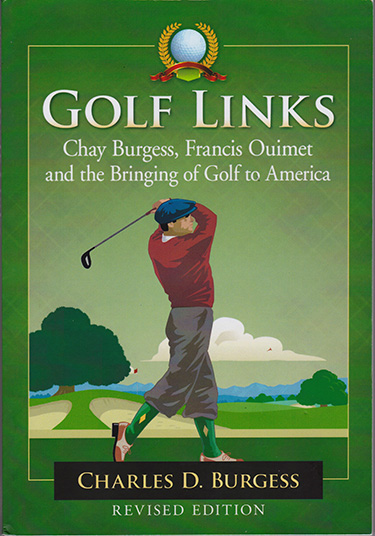Book Review
The Bulletin, September 2017, No 212

Golf Links
Chay Burgess, Francis Ouimet and the Bringing of Golf to America
By Charles D. Burgess
2017, McFarland, 252 pages, softcover
$35, ISBN 978-14766-6736-2
www.mcfarlandpub.com 800-253-2187
Also available as an ebook.
Review by Jim Davis
What a pleasant thing it is to find a ball that we had feared lost to deep rough resting serenely on an unexpected patch of short turf. In this game, you must learn to expect everything and expect nothing. Surprises may come with every shot, every bounce of the fairway, rub of the green.
Golf Links was such a surprise, a very pleasant one, too. What at first glance appeared to be a textbook biography instead proved a compelling tale of a Scottish immigrant who built a life in the U.S. through reliance upon solid core values that we wish our great men would follow today.
Author Charles D. Burgess is the great-grandson of the Scottish immigrant, whom we shall call Chay, as he became known in later years. Burgess took full advantage of his skills as a journalist and educational consultant to thoroughly research Chay’s life through family archives, newspapers, magazines, and books. His portrait never wavers from the straight line that Chay would have found appropriate off the first tee.
The larger picture of the wave of Scottish immigrants to the U.S. as the golf industry began to grow is well documented. Hundreds of these men took up positions at new courses that were coming along, mostly at private country clubs. Before he heeded the siren call, Chay, a native of Montrose, had built a name as a footballer as well as first-class golfer. He, his young wife, Harriet, and their new son, Charlie Jr., were setting up in Montrose where Chay was a budding golf professional and mason.
Over the next few years he was successful in a variety of tournaments that included the golfing greats of the day, including Vardon, Ray, Braid, Taylor and others. In 1909 Chay and his family moved to Boston where he had an offer to become the professional for the Woodland Golf Club.
Thus began a career that would see Chay become one of the foremost teachers in the country, a respected voice for golf professionals, and a mentor and friend to one of country’s most revered amateurs, Francis Ouimet.
Amazingly, he also found time for off-season football, or soccer, as he coached the new Harvard soccer squad to its first-ever intercollegiate championship in 1913. He would coach the team for several seasons.
Ouimet became a student of Chay’s during his high school years as the golf professional offered lessons for the Brookline High School players. The two became connected as student and teacher and later as lifelong friends. Chay provided encouragement and advice to Ouimet throughout that famous 1913 U.S. Open and afterward.
Chay’s success at Woodland brought him many pupils from baseball legends such as Babe Ruth to local hockey stars, and entertainers such as Bing Crosby, Al Jolson, and Jack Benny.
His son, Charlie Jr., became an apprentice and in 1919 they were regarded as perhaps the only father-son professional golfers for one club in the country.
In 1921, Chay organized the New England Professional Golfers Organization, in response to a the young PGA’s lack of attention to regional pros. With Chay as its first president, they instituted a series of tournaments where regional professionals could direct their own affairs, play in tournaments without having to travel long distances, and a benevolent fund for their members. It was a success and a wake-up call for the five-year-old PGA. As Burgess writes: “As a direct result of the 1921 insurrection of Chay’s New Englander golfers, a thorough reorganization of the PGA began at once and was completed by 1923.” It adopted a regional structure of smaller sections that could be administered by locally elected officer who had the needs of their regions in mind.
Chay was also instrumental in a fundraising effort to support the travel expenses of the 1929 American Ryder Cup team to Leeds, England.
Throughout two wars, this remarkable professional maintained a steadfast poise, a good humor, and a singular focus on good character both on and off the course. He studied with golf’s legends, from Old Tom Morris and Bob Dow, and learned from its early 20th century legends such as Vardon and Braid. He played with them all. He taught America’s first golf hero, Francis Ouimet, and continued to be available to all who visited him at his home at Woodland GC. He was feted by the club at its 50th anniversary in 1952, an event which featured two of his star amateur players – Francis Ouimet and Jess Guilford.
Chay died in 1960 at age 86. His legacy as a golfing pioneer is a singular one, for its scope, its longevity, for its impact on so many areas of the modern game, and for the many lives it touched.
Burgess’ treatment of this theme is quietly personal, yet deftly presents Chay’s life in full context with accurate and complete supporting details that never overwhelm, but help the greater picture come to a fuller life.
If you would come to a greater appreciation of what the early Scottish golf professionals brought to the United States, Chay Burgess in particular, then Golf Links is an inspiring, and welcome, addition to our understanding of what it means to be a golfer in America, and a gentleman worthy of respect.

